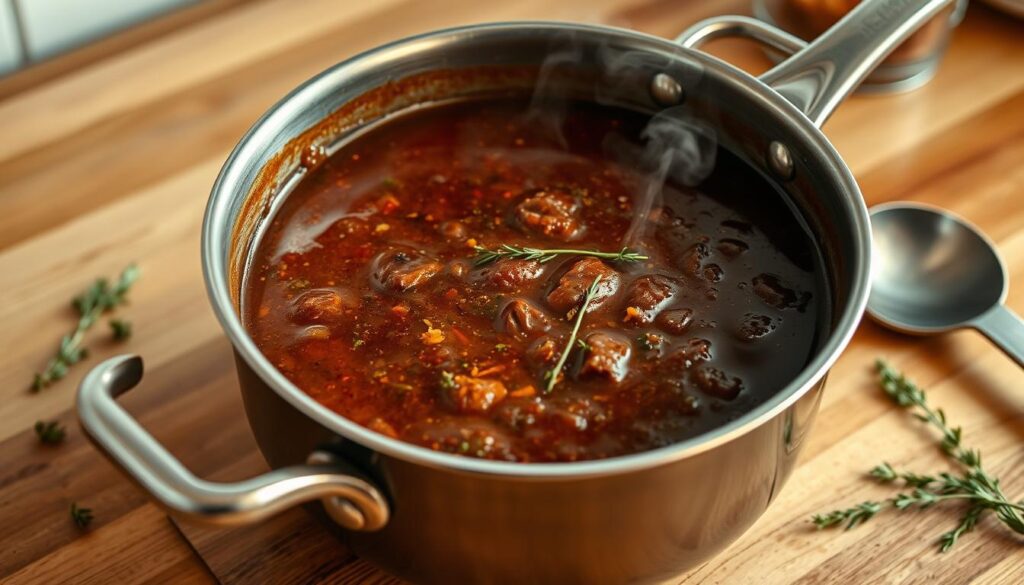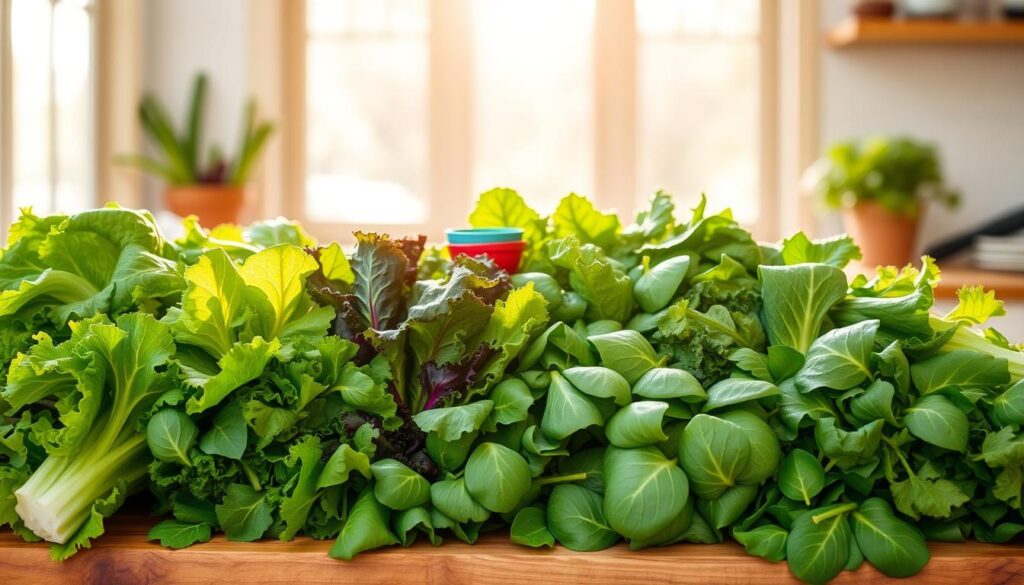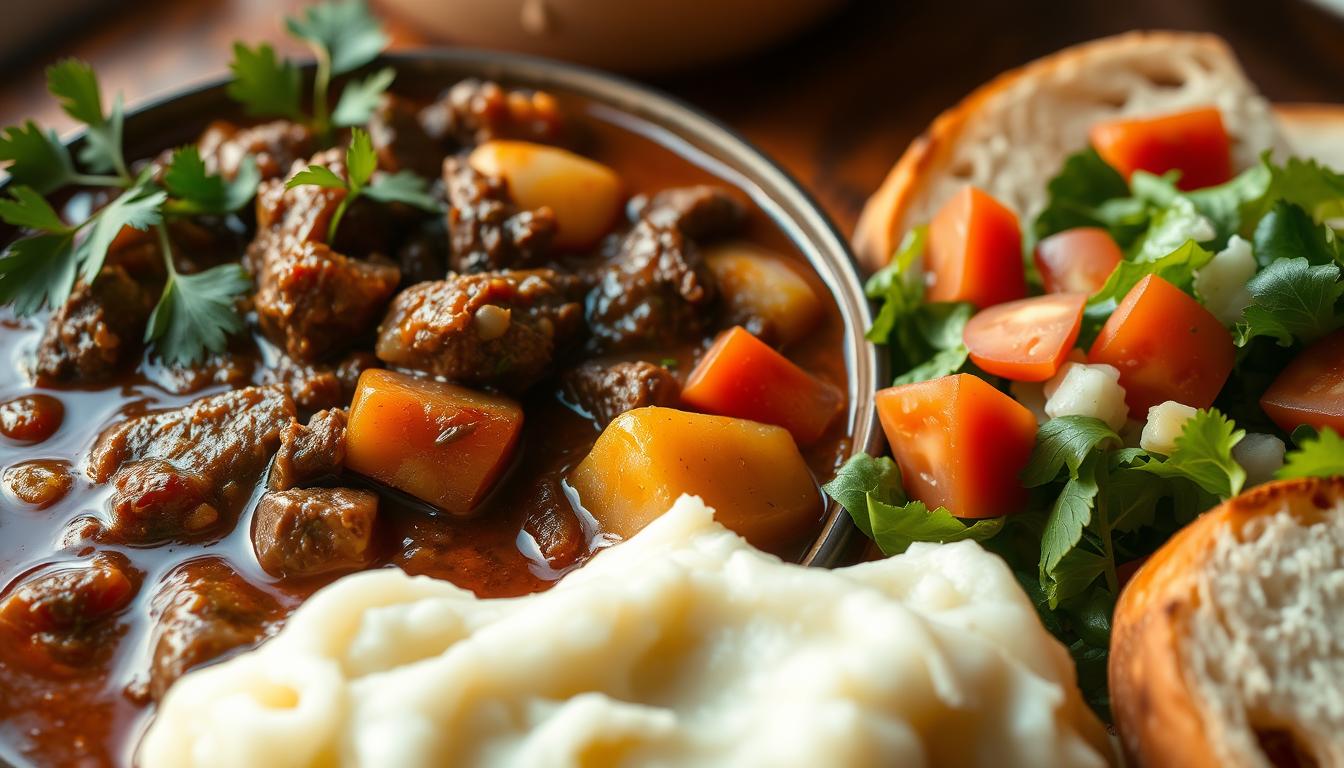Winter evenings always remind me of my grandmother’s kitchen. The aroma of simmering beef stew filled the house. It’s more than a meal; it’s a warm hug of tradition.
I’m sharing a classic beef stew with mashed potatoes and salad today. It turns a simple dinner into a hearty meal. This recipe is about more than food; it’s about sharing moments together.
Our meal has tender beef stew, creamy mashed potatoes, and a fresh salad. It’s a perfect mix for satisfaction and warmth. It’s great for feeding a family or hosting friends, offering both nourishment and a sense of home.
Key Takeaways
- Beef stew is a classic comfort food perfect for cold weather
- Total cooking time is approximately 3.5 hours
- Recipe serves 8-10 people generously
- Includes multiple cooking techniques for maximum flavor
- Combines protein, carbohydrates, and fresh vegetables in one meal
Understanding the Perfect Beef Stew Components
Making a memorable one-pot dish needs careful picking of ingredients and techniques. A home-cooked dinner like beef stew requires attention to detail. It starts with the basic parts that turn simple ingredients into a culinary masterpiece.
The heart of a great meat and potatoes meal is choosing high-quality ingredients. Each part is key to creating deep, complex flavors.
Selecting the Right Cut of Beef
Picking the perfect beef is key for a tender, flavorful stew. Experts say to use 3 pounds of boneless beef chuck with great marbling. This cut ensures:
- Rich, deep flavor
- Tender texture when slow-cooked
- Optimal fat content for moisture
Essential Aromatics and Vegetables
Aromatics are the flavor base of any great stew. For the best taste, add:
- 2 medium yellow onions
- 7 cloves of garlic
- 4 large carrots, cut into 1-inch chunks
- 1 bay leaf
- ½ teaspoon dried thyme
“The secret to a sublime stew is balancing flavors through carefully selected ingredients”
Wine and Broth Selection
Liquid parts make a simple stew into a gourmet dish. Use 2 cups of dry red wine like Pinot Noir or Cabernet Sauvignon, mixed with 2 cups of rich beef broth. This mix makes a luxurious base that turns your home-cooked dinner into a restaurant-quality meal.
Understanding these key parts helps you make a beef stew that’s more than just a meal. It’s a journey of flavors and textures.
Beef Stew with Mashed Potatoes and Salad: A Complete Meal Guide
https://www.youtube.com/watch?v=zX4W7uhVFNk
Making a memorable family recipe is more than cooking dishes. A slow-cooked stew turns a simple meal into a special event. This guide will show you how to make a delicious beef stew with perfect sides.
Your slow-cooked stew is the star of the dinner. Here are some ideas to make your meal unforgettable:
- Serve over creamy mashed potatoes for a hearty base
- Pair with a crisp vegetable side salad for freshness
- Accompany with artisan bread or popovers for dipping
- Optional: Serve over egg noodles or creamy polenta
For a great family recipe, mix flavors and textures. A light vegetable side can balance the rich stew. Try a simple salad with fresh greens, cherry tomatoes, and a light vinaigrette.
Pro tip: Prepare your vegetable side and stew components in advance to reduce day-of cooking stress.
Plan your meal with cooking times in mind. The stew needs 3 hours in the oven. Make sure your sides are ready at the same time for a perfect meal.
Secret Techniques for Tender, Flavorful Stew Meat
Making a tasty weeknight supper means knowing how to cook meat and veggies. Beef stew, a winter favorite, needs special steps to make tough cuts tender and juicy.
Professional chefs say the secret to great stew meat is in the preparation. It all starts with searing, which seals in juices and adds a tasty crust.
Mastering the Sear
Getting a good sear is all about paying attention:
- Use 1.5 lbs of beef cut into 1/2 to 1-inch bite-sized pieces
- Pat meat dry before cooking to ensure optimal browning
- Cook at medium-high heat for best results
- Sear meat in batches to prevent overcrowding
Braising Perfection
Braising turns tough meat into tender, soft bites. Keep the temperature at 325°F and cook for 2.5 to 3 hours. This slow cooking breaks down the meat, making it incredibly tender.
Wine-Based Sauce Magic
A wine-based sauce takes your dish from good to great. Use 1 cup of red wine to deglaze the pan, getting all the flavorful browned bits. This adds depth and complexity, making your meal feel like a restaurant experience.
Pro tip: Always choose a wine you’d enjoy drinking for the best flavor profile.
By using these techniques, anyone can make a delicious stew that will wow family and friends.
Creating Rich and Velvety Stew Sauce

Making the perfect sauce is key to slow-cooked meals. A rich, velvety stew sauce turns a simple dish into a family hit. It’s all about adding depth and keeping it smooth.
Thickening is crucial for the right sauce texture. Chefs suggest two main ways:
- Flour dredging for initial meat coating
- Roux-based thickening
- Cornstarch slurry for final sauce adjustment
Building great sauce flavor is all about layers. Begin by searing meat to get a deep crust. This crust adds flavor to the sauce. Use red wine and beef broth to start building the taste.
“A great sauce doesn’t just coat the meat—it tells a story of slow-cooked deliciousness.”
Here are some tips for perfecting your sauce:
- Reduce liquid slowly to concentrate flavors
- Whisk flour or cornstarch carefully to prevent lumps
- Simmer sauce until it reaches desired thickness
| Thickening Agent | Technique | Best Used For |
|---|---|---|
| All-Purpose Flour | Roux method | Rich, opaque sauces |
| Cornstarch | Slurry method | Glossy, translucent sauces |
| Arrowroot | Direct mixing | Lighter, delicate sauces |
Remember, patience is key in making a great stew sauce. Slow cooking blends flavors, turning simple ingredients into a family favorite.
Mastering Creamy Mashed Potatoes
Making the perfect potato side dish is key to a cozy home-cooked dinner. Mashed potatoes add a creamy touch that makes any meal special. They pair well with hearty beef stew.
Choosing the right potatoes is important for a smooth texture. Yukon Gold potatoes are the best for mashed potatoes. They have a buttery flavor and creamy texture.
Potato Variety Selection
- Yukon Gold: Ideal for creamy, buttery mashed potatoes
- Russet potatoes: Great for a fluffier texture
- Red potatoes: Offer a waxy, dense consistency
Mashing Techniques and Flavor Boosters
The secret to great mashed potatoes is in the technique and ingredients. Here’s how to make the ultimate potato side dish:
- Boil potatoes until very fork tender (about 25 minutes)
- Drain well to avoid watery potatoes
- Add warm ingredients for creaminess:
- 6 tablespoons of salted butter
- 1/2 cup sour cream
- 1 cup half & half
- Season with salt and black pepper to taste
This recipe makes 6.5 cups of mashed potatoes, serving 4-6 people. It’s also nutritious, with 591 calories per serving.
Pro tip: Warm your dairy ingredients before mixing for a smooth, creamy texture. It will make your mashed potatoes truly outstanding!
Fresh Garden Salad Preparation

Making a vibrant vegetable side is great with hearty beef stew. A fresh garden salad is a crisp, light contrast to rich main dishes. Choosing the right leafy greens is key to a great salad that makes your meal better.
When making your salad, keep these points in mind:
- Choose a mix of fresh leafy greens for depth and texture
- Select seasonal vegetables for maximum flavor
- Create a simple yet delicious dressing
- Balance colors and nutritional value
Begin by picking a variety of leafy greens. Romaine, arugula, spinach, and mixed spring greens offer different tastes and nutrients. Make sure to wash and dry your greens well for crispiness. Cut or tear them into small pieces for easy eating.
Add colorful veggies like cherry tomatoes, cucumber slices, and thinly sliced red onions. You can also add protein like crumbled feta or sliced almonds. A light vinaigrette with olive oil, lemon juice, Dijon mustard, and herbs will bring it all together.
The aim is to make a refreshing salad. It should offer texture and nutritional balance to your beef stew and creamy mashed potatoes.
Perfect Timing: Coordinating Three Dish Components
Preparing a one-pot dish like beef stew for a weeknight supper needs careful planning. Learning to coordinate meals makes dinner time enjoyable and stress-free. It’s all about matching cooking times and keeping the kitchen organized.
Strategic Meal Prep Schedule
Creating a smooth cooking flow makes your weeknight supper peaceful. Here’s a plan to help you manage your beef stew, mashed potatoes, and salad:
- Start beef stew first, as it takes the longest to cook
- Prepare vegetables and salad while the stew simmers
- Start making potatoes about 45 minutes before dinner
- Put together the salad as the stew finishes cooking
Temperature Management Techniques
Keeping dishes at the right temperature is key for a great meal. Here are some tips from the pros to keep your food warm and fresh:
| Dish | Recommended Temperature | Holding Method |
|---|---|---|
| Beef Stew | 160-170°F | Low simmer, covered |
| Mashed Potatoes | 140-150°F | Covered, with small amount of warm milk |
| Garden Salad | 40-45°F | Refrigerated until serving |
By sticking to these timing and temperature tips, you’ll make your one-pot dish a hit. It will impress your family without stressing you out in the kitchen.
Make-Ahead and Storage Solutions
Turning a family recipe into a quick meal needs smart storage tips. Your beef stew can save the day on busy weeknights. It’s a perfect choice for a home-cooked dinner when time is tight.
Keeping your stew fresh is key. Here’s how to keep its flavors intact:
- Refrigerate the stew in an airtight container
- Store for up to 3-4 days in the refrigerator
- Freeze for extended preservation up to 3 months
Pro tip: Separate mashed potatoes before freezing, as they don’t maintain optimal texture when frozen.
| Storage Method | Duration | Recommended Container |
|---|---|---|
| Refrigerator Storage | 3-4 days | Airtight glass or plastic container |
| Freezer Storage | Up to 3 months | Freezer-safe container or heavy-duty freezer bags |
When reheating, slowly warm the stew on the stovetop. This keeps its rich flavors and tender meat. For frozen stew, thaw in the fridge overnight. Then, gently reheat it. This way, your family recipe stays delicious.
A perfectly stored stew can be your secret weapon for quick, satisfying home-cooked dinners!
Wine Pairing and Serving Suggestions
Enhancing your hearty meal is more than cooking—it’s about the whole dining experience. Choosing the right wine can turn beef stew into a special moment. Dry red wines like Cabernet Sauvignon, Merlot, and Pinot Noir pair well with the stew’s rich flavors.
Experts say to match the wine’s strength with the dish’s depth. A bold Cabernet Sauvignon pairs well with the beef. A smooth Merlot offers a softer contrast. For a lighter touch, a Burgundy Pinot Noir adds elegant notes that blend with the stew’s spices.
Present the stew in a rustic dish, topped with fresh herbs and served with crusty bread. Red wines should be at 60-65°F for the best taste. Decanting the wine 30 minutes before adds to the experience, making the meal feel like a gourmet event.
For guests, try a wine flight with small wine samples. This lets everyone see how different wines match the stew. It makes the meal fun and memorable. The aim is to make dining warm and enjoyable, celebrating food and wine together.
FAQ
What is the best cut of beef for making a hearty stew?
Chuck roast or beef shoulder are top picks for stew. They have lots of marbling, making the meat tender when slow-cooked. These cuts break down well, creating rich, tender meat perfect for a cozy winter meal.
How long should I cook beef stew to ensure the meat is tender?
For tender meat, cook your stew for 2-3 hours on low heat. Use a Dutch oven or slow cooker. This method breaks down tough fibers, making the meat tender and easy to shred.
Can I make beef stew ahead of time?
Yes, beef stew is great to make ahead. In fact, letting it sit overnight can enhance the flavors. Cool it, store it in an airtight container, and reheat gently when you’re ready to eat.
What type of wine works best in beef stew?
Dry red wines like Cabernet Sauvignon, Merlot, or Pinot Noir are excellent. They add depth and complexity to the sauce, tenderizing the meat and enriching the flavor.
How can I thicken my beef stew sauce?
You can thicken the sauce with a roux, cornstarch slurry, or by simmering it uncovered. Each method helps create a richer, clingier sauce.
What are the best potatoes for making mashed potatoes?
Russet or Yukon Gold potatoes are great for mashed potatoes. Russets make them fluffy, while Yukon Golds are creamy and buttery. Yukon Golds are especially popular for their smooth texture.
What kind of salad pairs well with beef stew?
A crisp green salad with mixed greens, light vinaigrette, and fresh veggies is perfect. It offers a refreshing contrast to the stew, balancing the meal.
Can I freeze beef stew?
Yes, beef stew freezes well. Store it in airtight containers or bags for up to 3 months. Thaw it in the fridge overnight and reheat gently.
What sides go well with beef stew besides mashed potatoes?
Try crusty bread, rice, egg noodles, or roasted veggies with stew. Choose a side that soaks up the sauce and complements the flavors.
How can I add more flavor to my beef stew?
Use onions, garlic, and herbs for flavor. Add Worcestershire sauce and beef stock for depth. Brown the meat well before slow cooking for richer flavors.

